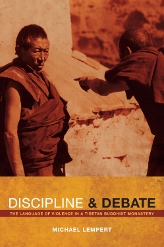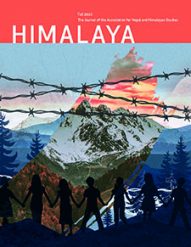News
Expanded Book Review: Discipline and Debate

Discipline and Debate: The Language of Violence in a Tibetan Buddhist Monastery. By Michael Lempert. Berkeley: University of California Press, 2012. 238 pages. ISBN 9780520269460.
Reviewed by Brenton Sullivan
As the title and subtitle suggest, Michael Lempert’s Discipline and Debate examines how Tibetan Buddhist monks in exile have rethought and reformed some of their more “violent” practices in order to accord with the image of nonviolence and “universal compassion” projected onto Tibetans and radiated outward from the Dalai Lama. In particular, it provides a unique look into Tibetan Buddhist debate and its disciplinary practices as exhibited at Sera Monastery’s Mey College in Bylakuppe, India. The book’s central concern is to examine how monks and monastic reformers have aspired to become “modern liberal subjects,” which they have done by “adjust[ing] and selectively highlight[ing] qualities of face-to-face interaction—in particular, male-monastic rites of socialization, from reprimand to verbal argument—so that foreign spectators, real and imagined, may see some of their own aspirations reflected in these performances” (p. 10). The theoretical basis to Lempert’s argument comprises what he calls “liberal sympathies,” “sympathies” here referring to the ways in which Tibetans affect and gain recognition by those who are already considered “liberal subjects,” namely Westerners, with the hope of securing political and economic support.
The reason that these monks and reformers are compelled to adjust their practices and the way they talk about these practices is the apparent tension caused by monastic “debate and discipline in an age of reason and rights” (p. 14). The first two chapters of the book describe debate—specifically, “formal debate” or “defense” (dam bca’)—and the social and institutional context for debate. The second chapter is particularly compelling. Unlike previous accounts of Tibetan Buddhist debate (e.g. Dreyfus 2003; Perdue 1992; Onoda 1992), Lempert goes beyond what scholastic “textbooks” and other texts can tell us about the “denotational” values of debate and provides an unprecedented view of debate’s “interactional” components. The chapter examines such analytical values as the timing of taunts during a debate, the spatial positioning of its participants, the rate of speech, and so forth, and this is presented in easily digestible forms such as transcripts, drawings, and quantitative charts.
The second chapter leaves the reader with the impression that debate at Sera Mey is still thoroughly illiberal, due to the absolute reverence for scriptural authority, the prominence of hierarchical distinctions between debate participants, and the “violent” verbal barrage executed by the challenger in the debate. However, the following chapter dispels such a conclusion by introducing the reflexive discourse of the Dalai Lama and others in the Geluk sect, a discourse that reframes debate to fit with modern, liberal sensibilities. Lempert analyzes the Dalai Lama’s Tibetan-language speeches from the past five decades and elaborates on the attention given therein to reason in Buddhism and (by extension) debate. A key trope that is valorized in these speeches, he argues, is the virtue of “firmness” (bstan po) derived from “reasoned faith” (rgyu mtshan mthong ba’i dad pa, rgyu mtshan mthong nas dad pa, or rgyu mtshan shes nas thob pa’i dad pa) (pp. 98-100). Such firmness “typifies a self that resists the pressures of assimilation and conversion, that never loses sight of the fact that one is Tibetan and that one’s religious patrimony is Buddhism” (p. 98). Lempert draws a connection between this discourse and debate, particularly the debate defendant’s “unflappable poise,” which he describes as mimicking the “firmness” advocated in the Dalai Lama’s speeches: “Those who inhabit the defendant role in India are also diasporic subjects by default, which also helps motivate this likeness in which the defendant in debate exemplifies the ideal diasporic subject in exile” (p. 103).
Chapters Four and Five turn to the question of monastic discipline, specifically as it is carried out in the “public reprimand,” or disciplinary sermon (tshog gtam). Chapter Four provides a unique description of the public reprimand at Sera Mey. The transcript of a public reprimand delivered by the college’s disciplinarian is analyzed to reveal the different “voices” taken on by the disciplinarian during his sermon, a method the disciplinarian effectively employs to raise the specter of incrimination in as many listening monks as possible. For scholars of monastic practice like myself, this provides an important and unique ethnographic account of an institutionalized practice that is prescribed but seldom described in the customaries of major Geluk monasteries. This disciplinary practice, too, now exhibits characteristics of modernity. Specifically, Lempert emphasizes the prominence of argument, reason, and self-critique in the language of the disciplinarian (p. 134). Moreover, corporal punishment is on the decline, says his informants, due principally to “the gaze of a superaddressee, the West” (pp. 138-140).
Chapter Five examines the surrounding discourses that have motivated these changes in disciplinary practice, the Dalai Lama again being the principal source of these discourses. In addition, the chapter compares discipline at Sera Mey to the recognizably more modern and liberal Institute of Buddhist Dialectics in Dharamsala. Here one is said to find a diminished role of the disciplinarian, a preference for “gentle advice” and personal discipline, the use of new “analogical punishments” (e.g., circumambulation, full-body prostrations, kitchen duties), an egalitarian sentiment, and a lack of special privileges for monks with received religious status (pp. 149, 139). Lempert concludes that these innovations are the consequence of Tibetans courting the affective sympathies of potential onlookers (p. 152).
The book’s ideal audience is made up of other scholars of linguistic anthropology and Tibetan Buddhism, although sections of the book could be assigned to undergraduate students in courses in these fields. Lempert anticipates some unfamiliarity and frustration among scholars from Tibetan and Buddhist studies stemming from the book’s thick description and analysis of the language used in debate and public reprimand. As such, he suggests that these readers might skip these sections of the book. I, however, have found these sections—comprising the cores of Chapters Two and Four, respectively—to be the most interesting and coherent parts of the book.
Meanwhile, I am more skeptical of the theoretical leaps made in the book’s capstone chapters—Chapters Three and Five—that attempt to show how the ‘haunting’ presence of Westerners and the elevated discourse of the Dalai Lama actually compel monastic officials and ordinary monks to think differently about their monastic practices and even to reform how those practices are carried out. These arguments give quite a bit of credit to the West and to a single individual (i.e. the Dalai Lama) and not very much to the thousands of ordinary monks themselves. Lempert himself acknowledges on a few occasions that the reforms in question were reframed “by some, not all” (p. 83), that there were in fact “various motivations” for reforming Geluk institutions (p. 130), and that educators and administrators at Sera Mey have not been responding to the gaze of actual Westerners and others but merely to “potential spectators” (p. xxx).
As an anthropological study of contemporary Buddhist practices and discourses, what is absent is a thorough consideration of the historical and internal dynamics of Tibetan monasticism that might better explain the contemporary practices that Lempert observed and so closely analyzed. Are Sera Mey monks truly “diasporic subjects by default”? Are they not equally “Tibetan subjects” or “Buddhist subjects” by default? When I read of the “new” and “modern” disciplinary practices employed at the Institute of Buddhist Dialectics in Dharamsala, I was immediately struck not by their resemblance to modern or Western practices but by their resemblance to the disciplinary practices advocated by the eighteenth-century lama-scholar Sumpa Khenpo, three-time abbot of a major monastery in northeastern Tibet during the eighteenth century (Ye shes dpal ‘byor 2001). As abbot of Gönlung Jampa Ling, Sumpa Khenpo preferred to instill discipline using “gentle” (‘jam po) words, “never giving a single, pointless public reprimand” (pp. 338-9). He encouraged personal discipline, “for beyond being embarrassed of oneself what else is there? (p. 557; see also p. 341).” Conversely, he discouraged the use of corporeal punishment, citing verses of the Indian sage Nāgārjuna that explain that “… though you beat them … the tamed ones they become / Are not good, suitable vessels for learning” (p. 339; see also pp. 565-566). Sumpa Khenpo did not even issue fines, instead preferring “religious discipline” (chos bzhin ‘dul ba) “in accordance with the monastic customaries composed by previous generations such as Butön and Lord Tsongkhapa.” These included, notably, such “analogical punishments” as making prostrations, doing circumambulations around the monastery, and doing chores and labor around the monastery (p. 340). Sumpa Khenpo’s attitude of restraint was part of a larger atmosphere of egalitarianism that he promoted at his monastery. He rejected the practice of monastic officials receiving a privileged number of shares (p. 340), and he appointed to office those monks who were worthy and capable “no matter their age, training, tribe, or village” (pp. 271-272).
Thus, either we are compelled to consider the “modernity” of monks and lamas from Tibet’s past, such as Sumpa Khenpo, or we must consider the possibility that present-day monks at Sera Mey and other Buddhist institutions in exile in fact think very little about us and the higher discourses emanating from Dharmasala and that they may just be doing what they have always done: debate and discipline. Regardless, Discipline and Debate succeeds in presenting the reader with a logical argument and an interesting and plausible explanation for why monastic debate has persisted in exile with only minor modifications while monastic disciplinary practices have been subject to greater scrutiny and change.
Brenton Sullivan is a post-doctoral research fellow in the Department of Asian Studies and the Cultural Evolution of Religion Research Consortium at the University of British Columbia. His research is focused on the development of “mega monasteries” in Tibet in the seventeenth and eighteenth centuries. His research interests include the administration of religious communities in Tibet and China, Sino-Tibetan relations in the late Ming and Qing dynasties, and the religious history of northeastern Tibet (Amdo) / western China.
References
Dreyfus, Georges. 2003. The Sound of Two Hands Clapping. Berkeley: University of California Press.
Perdue, Daniel. 1992. Debate in Tibetan Buddhism. Ithaca: Snow Lion.
Onoda, Shunzo. 1992. Monastic Debate in Tibet. Wien: Arbeitskreis für Tibetische und Buddhistische Studien, Universität Wien.
Ye shes dpal ‘byor, sum pa mkhan po. 2001. paN+Di ta sum pa ye shes dpal ‘byor mchog gi spyod tshul brjod pa sgra ‘dzin bcud len. Beijing: Krung go’i bod rig pa dpe skrun khang.
